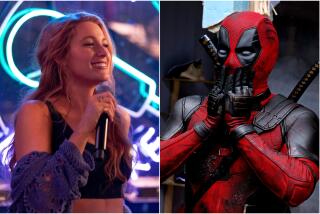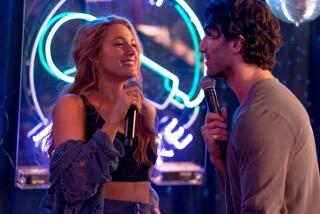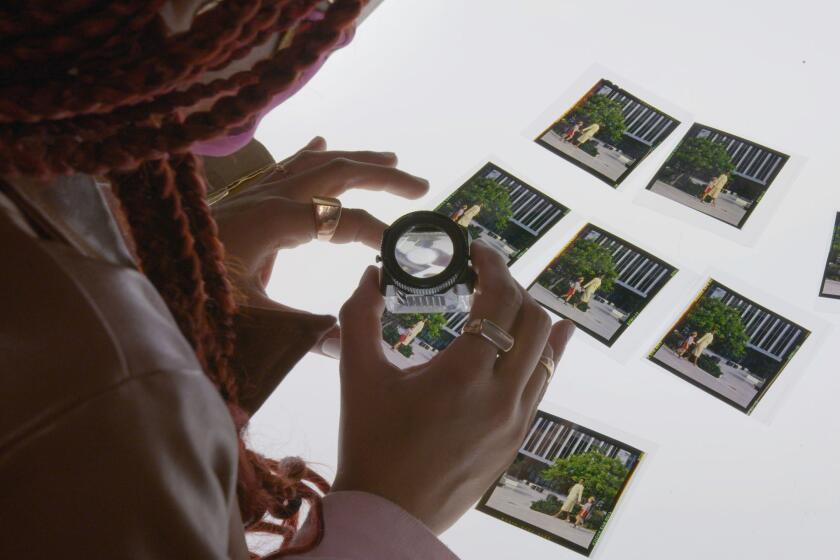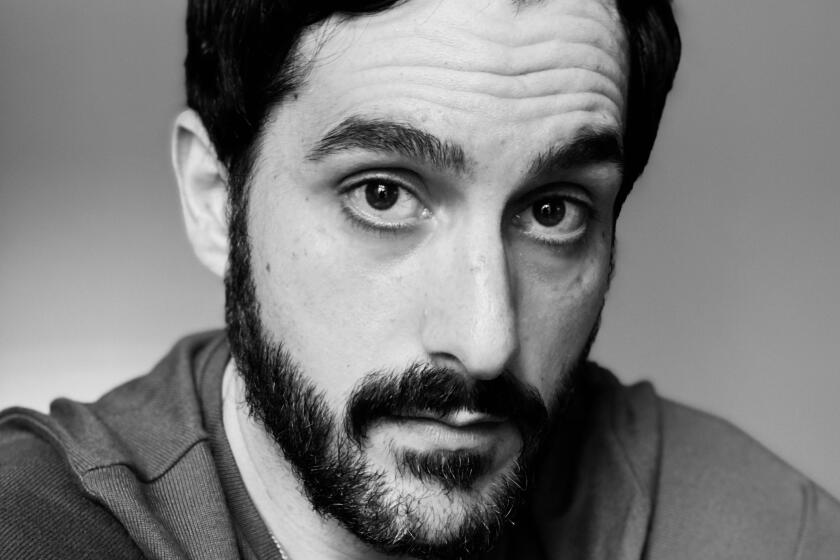Crazy internet theories about ‘Us’: The L.A. Times debates
Jordan Peele’s “Us” is designed to get people talking. The director acknowledged as much while dodging a question about the film’s meaning at its SXSW premiere. “My favorite thing is the idea that people will leave ready to have a conversation — with whoever they’re with.”
The movie-going world has taken up that challenge. “Us” has spurred discussion and speculation about the movie’s twist ending and what it really signifies on internet message boards, in megaplex lobbies and seemingly everywhere else in the week since its release.
In an effort to sort through the fruits of those conversations — the wildest theories and most intriguing insights — the Los Angeles Times convened Mark Olsen, Justin Chang, Sonaiya Kelley and Jen Yamato for a discussion on our office messaging platform. Spoilers abound in the conversation below.
MARK OLSEN Just like anyone, we left the theater with questions and we can’t stop talking about them. How long can a person survive on raw rabbit? Are there tunnels underneath the entirety of the United States? I have found myself particularly obsessing over the significance of a T-shirt for the punk band Black Flag, worn once by a carnival worker in the 1980s and again on a bratty contemporary teenager. The band’s distinctive Raymond Pettibon-designed logo echoes the images of 11:11 that recur throughout the movie, but to me the shirt also points toward how things come back, often in ways that can’t be anticipated. What once signified rebellion returns as a commodity, or, as with Hands Across America, what once was a tepid benevolence becomes something dark and malevolent. Can you understand the kind of rabbit holes this movie sends people down?
Justin, you just re-watched the movie yesterday. What jumped out at you on a second viewing?
JUSTIN CHANG Those rabbits certainly hopped out at me on second viewing. The first time I saw “Us,” I was too enthralled by the sheer wealth of ideas Jordan Peele was toying with — and also too floored by his razor-sharp horror technique — to give much though to the bunnies beyond the possibility that Peele had somehow managed to turn around a stealth sequel to “The Favourite.” The rabbits are, of course, an emblem of a failed government experiment that sought to control the actions of the untethered by means of the tethered. They are a stand-in for the great human multiplicity that the tethered represent. And of course, speaking of rabbit holes, they are a sly allusion to “Alice in Wonderland,” another story about a young girl who ventures into a world gone topsy-turvy.
What else jumped out at me? Once again, the astounding dual performance of Lupita Nyong’o as both Adelaide, a woman reliving her childhood trauma, and Red, a scissors-wielding doppelgänger with murderous revenge in her heart — only this time, of course, I watched the movie knowing the more complicated truth, that Red is in fact Adelaide and Adelaide has been Red all along. What seemed the first time like an ingenious final twist revealed itself the second time, almost entirely through Nyong’o’s acting, as strikingly direct, even obvious: Watch “Adelaide’s” cries of “No, no, no” when the doppelgängers first show up and you’ll realize you’re not just hearing fear, but also guilt. Listen to the guttural grunts in her voice after she stabs one of her assailants to death and you will hear the deep, primal rage of a woman who has never forgotten her treacherous roots.
The ending of ‘Us’: Jordan Peele on who the real villains are »
MARK OLSEN Sonaiya, you mentioned an original “The Twilight Zone” episode that seemed to be a not-so-secret formative text to the movie. (And a nice bit of cross-promotion to Jordan Peele’s revived vision of the show?)
SONAIYA KELLEY Right, Jordan Peele has not been shy about the fact that he was inspired to write this movie by an early episode of “The Twilight Zone” called “Mirror Image.” I went back to watch the episode, which follows a young woman who is driven to the brink of insanity when she is confronted with her own smiling doppelgänger in an empty bus station. Toward the end of the film, she basically delivers a monologue about the possibility that each person on earth has their own copy and that only one person can exist, which provides almost a full foundation for this film.
As for the rabbits, one thing I hadn’t noticed until the second watch was how in the beginning, right after young Addy comes face to face with her counterpart, before the credits roll, the shot changes to a close-up of a caged rabbit, which is a nice bit of foreshadowing as to her fate.
JEN YAMATO “Mirror Image” is a fantastic blueprint for what Peele does in “Us” for a few reasons. For one, the set-up is relatively simple — a young woman waiting with a suitcase at a bus depot questions her own sanity — so the suspense comes from a very internal performance, and from the viewer paying close attention to seemingly mundane details. What’s more, like many of Rod Serling’s “Twilight Zone” vignettes, it has the confidence not to provide all the answers we want. And that’s how “Us” builds its own original, expansive mythology.
We get bits and clues of what tethered behavior looks like, but no scientific explanations of how it all works. We see the tunnels where the tethered live — Peele calls this place “The Underpass” — but not how far those tunnels reach, if they get WiFi down there, if there’s a convenient Amazon.com drop-off location for all the bulk orders of red jumpsuits and single driving gloves and brass scissors Red’s been placing ... and that ambiguity, whether fully intentional, makes us fill in the blanks.
But to debunk one of the wildest of all those internet theories, I’ll make my stand: Jason is 100% not Pluto. It doesn’t make sense! I can’t get on board.
MARK OLSEN We’ll get to Jason and Pluto in a moment.
SONAIYA KELLEY So I just realized Jordan Peele has a tell in his filmmaking technique. With “Us,” when the credits roll over the pan-out shots of the rabbits with the creepy song playing, it foreshadows Adelaide’s capture, and the shot/location is not revisited until the end when the real Red returns to the underground holding area. And with “Get Out,” when that creepy “Sikiliza” song is playing over the credits, it’s a shot of the forest where the final action takes place in the end with Rose and Chris. Very small thing, but I wonder if it’ll carry over in his future films?
MARK OLSEN I think Jordan Peele does give the feeling that everything that is packed into his films, “Us” in particular, is all very planned out and intentional. I think that’s one of the reasons people are parsing “Us” so closely. Nothing feels accidental, even as the film feels sprawling and a bit messy.
Jordan Peele wants Americans to ‘face their demons’ in ‘Us’ »
JEN YAMATO Here’s my craziest personal theory, after (only) two viewings: What if what we know of the Underpass and the tethered isn’t quite correct? We only learn about the secret failed government experiment from Red’s explanation to Adelaide of how the shadow people came to be. It’s what she thinks happened; it is her subjective understanding. Well, she also thinks throwing a giant holding-hands murder party is going to correct decades of systemic abuse and neglect. What if she doesn’t have the full picture herself?
Righteous as Red’s odyssey is in her own way — she is herself a survivor and a leader, and from her perspective the tethered uprising is a valid and just action — she’s also gone a bit batty down there all these years, and her sense of morality and justice is still grounded in the false optimism she absorbed, through 9-year-old eyes, from America circa 1986. “Us” has neither a morally reliable protagonist nor antagonist, which is what makes it so powerful a text to unravel.
MARK OLSEN I think this idea is so great, Jen. And it points toward one of my favorite things about the movie, that you actually can view the whole story from a perspective where the tethered are the heroes, like the rebel alliance fighting for freedom.
Which leads us to what may be the whopper of theories circulating around the internet: that somehow young Jason and his tethered Pluto were actually switched just like Adelaide and Red sometime before the story began. I thought this was a preposterous idea at first, but I may be coming around to it. Justin, watching the movie again, did this seem plausible?
JUSTIN CHANG I eagerly await Jen’s rebuttal, but yes, after seeing the movie again, the notion that Jason and Pluto have already swapped places before the movie opens strikes me as not just plausible, but also eye-opening. It clarifies the strange unease that sets in when the Wilsons arrive at their vacation home — a home they come back to every year, which is crucial — and the suggestion that whatever is afflicting Jason (played by the remarkable Evan Alex), his lack of mental focus and physical coordination, is a recent development. It explains the strange physical and psychological bond that Adelaide and Jason (or rather, Red and Pluto) seem to share throughout the whole movie, the sense that they both know or suspect something the rest of us don’t.
Most of all, it makes sense of a scene that briefly drove me mad the first time I saw it: Shortly before the movie’s climax, how does Jason, walking backward, manage to dictate Pluto’s movements and send him to his fiery death? Well, if Jason is in fact Pluto and vice versa, then the until-recently tethered boy might still exercise some residual control over the newly tethered one’s footsteps. What others have criticized as an example of the movie’s incoherence, its conceptual overreach, now feels like a crucial piece in a brilliant overall design.
SONAIYA KELLEY I just don’t think the timeline makes sense. How would Pluto and Jason swap places? While they are back at their vacation home every year, this must be the first year Adelaide (really her tethered doppelganger) returns to the boardwalk, or many of the foundations of the film fall apart. I think Jason, though he struggles to focus, is way too articulate and curious to have formerly been tethered. I think Jason finally managed to catch on after he was kidnapped by Red (really Adelaide). He must have overheard her conversation with his mother during their struggle and noticed something amiss. I think Jason is the youngest so his imagination is still relatively unspoiled. He learned in the closet that Pluto’s movements mimic his; the scene with the car fire was likely just quick thinking.
JUSTIN CHANG: Hmm, Sonaiya, that all makes sense as well. I’m curious; what do you and Jen make of the burn scars on Pluto’s face? They offer perhaps the strongest (and most disturbing) evidence for the Jason-is-Pluto theory, which is that every time “Jason” has been trying in vain to make his magic trick with the lighter work, in the sunken place “Pluto” has been matching his movements — and burning his face in the process.
SONAIYA KELLEY I hadn’t even connected Jason’s lighter trick with Pluto’s burns. I just took Red’s claim that he was attracted to fire at face value.
JEN YAMATO Agree with Sonaiya: The rest of the movie doesn’t support this admittedly intriguing theory. But I do think Jason’s mannerisms are a reflection of a secret tethered identity; he is half-tethered, after all! Where Zora takes after dad Gabe and would rather lose herself in digital distractions, Jason shares his mom’s sensitivity to the shadows.
The Jason-Pluto relationship is interesting and potentially informative, because it provides a contrast in the mechanics of the tether according to age. I assumed that the younger you are, the stronger your tether was to your other half. As you grow older — and develop a stronger sense of free will as an individual — the power of the tether weakens.
That might explain why Adelaide and Red as young girls in 1986 were drawn toward one another like magnets in the funhouse, but by their teenage years that tether had been warped like a bad signal. When tethered Adelaide dances “The Nutcracker” above ground, Human Red is resistant to and resentful of the link but still connected to the dance — even if exactly how the connection works remains a mystery.
Getting to the bottom of that “how” could also explain the burn marks on Pluto’s face. Maybe whoever is above ground controls their counterpart below — because the government experiment to achieve the opposite has utterly failed? Give us the prequel that explains it all!
More to Read
Only good movies
Get the Indie Focus newsletter, Mark Olsen's weekly guide to the world of cinema.
You may occasionally receive promotional content from the Los Angeles Times.










